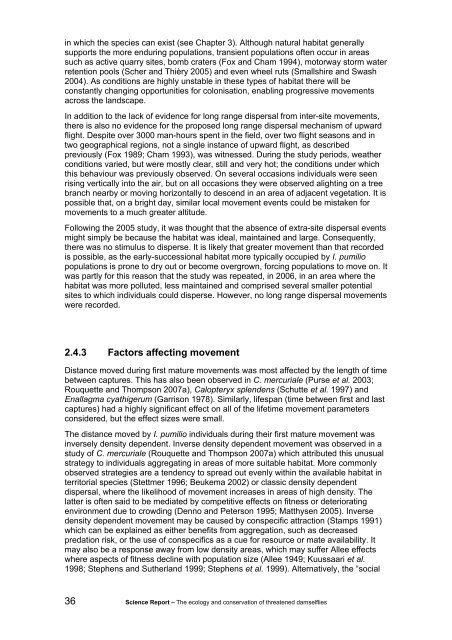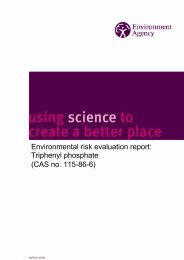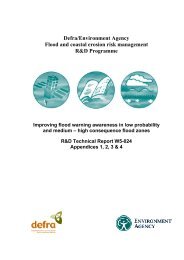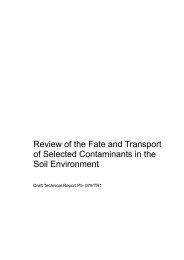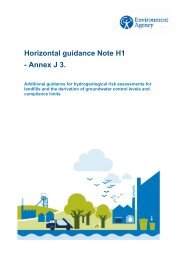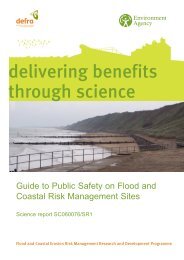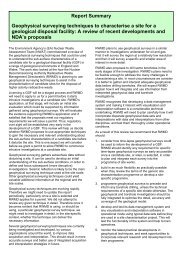The ecology and conservation of threatened damselflies
The ecology and conservation of threatened damselflies
The ecology and conservation of threatened damselflies
You also want an ePaper? Increase the reach of your titles
YUMPU automatically turns print PDFs into web optimized ePapers that Google loves.
in which the species can exist (see Chapter 3). Although natural habitat generally<br />
supports the more enduring populations, transient populations <strong>of</strong>ten occur in areas<br />
such as active quarry sites, bomb craters (Fox <strong>and</strong> Cham 1994), motorway storm water<br />
retention pools (Scher <strong>and</strong> Thièry 2005) <strong>and</strong> even wheel ruts (Smallshire <strong>and</strong> Swash<br />
2004). As conditions are highly unstable in these types <strong>of</strong> habitat there will be<br />
constantly changing opportunities for colonisation, enabling progressive movements<br />
across the l<strong>and</strong>scape.<br />
In addition to the lack <strong>of</strong> evidence for long range dispersal from inter-site movements,<br />
there is also no evidence for the proposed long range dispersal mechanism <strong>of</strong> upward<br />
flight. Despite over 3000 man-hours spent in the field, over two flight seasons <strong>and</strong> in<br />
two geographical regions, not a single instance <strong>of</strong> upward flight, as described<br />
previously (Fox 1989; Cham 1993), was witnessed. During the study periods, weather<br />
conditions varied, but were mostly clear, still <strong>and</strong> very hot; the conditions under which<br />
this behaviour was previously observed. On several occasions individuals were seen<br />
rising vertically into the air, but on all occasions they were observed alighting on a tree<br />
branch nearby or moving horizontally to descend in an area <strong>of</strong> adjacent vegetation. It is<br />
possible that, on a bright day, similar local movement events could be mistaken for<br />
movements to a much greater altitude.<br />
Following the 2005 study, it was thought that the absence <strong>of</strong> extra-site dispersal events<br />
might simply be because the habitat was ideal, maintained <strong>and</strong> large. Consequently,<br />
there was no stimulus to disperse. It is likely that greater movement than that recorded<br />
is possible, as the early-successional habitat more typically occupied by I. pumilio<br />
populations is prone to dry out or become overgrown, forcing populations to move on. It<br />
was partly for this reason that the study was repeated, in 2006, in an area where the<br />
habitat was more polluted, less maintained <strong>and</strong> comprised several smaller potential<br />
sites to which individuals could disperse. However, no long range dispersal movements<br />
were recorded.<br />
2.4.3 Factors affecting movement<br />
Distance moved during first mature movements was most affected by the length <strong>of</strong> time<br />
between captures. This has also been observed in C. mercuriale (Purse et al. 2003;<br />
Rouquette <strong>and</strong> Thompson 2007a), Calopteryx splendens (Schutte et al. 1997) <strong>and</strong><br />
Enallagma cyathigerum (Garrison 1978). Similarly, lifespan (time between first <strong>and</strong> last<br />
captures) had a highly significant effect on all <strong>of</strong> the lifetime movement parameters<br />
considered, but the effect sizes were small.<br />
<strong>The</strong> distance moved by I. pumilio individuals during their first mature movement was<br />
inversely density dependent. Inverse density dependent movement was observed in a<br />
study <strong>of</strong> C. mercuriale (Rouquette <strong>and</strong> Thompson 2007a) which attributed this unusual<br />
strategy to individuals aggregating in areas <strong>of</strong> more suitable habitat. More commonly<br />
observed strategies are a tendency to spread out evenly within the available habitat in<br />
territorial species (Stettmer 1996; Beukema 2002) or classic density dependent<br />
dispersal, where the likelihood <strong>of</strong> movement increases in areas <strong>of</strong> high density. <strong>The</strong><br />
latter is <strong>of</strong>ten said to be mediated by competitive effects on fitness or deteriorating<br />
environment due to crowding (Denno <strong>and</strong> Peterson 1995; Matthysen 2005). Inverse<br />
density dependent movement may be caused by conspecific attraction (Stamps 1991)<br />
which can be explained as either benefits from aggregation, such as decreased<br />
predation risk, or the use <strong>of</strong> conspecifics as a cue for resource or mate availability. It<br />
may also be a response away from low density areas, which may suffer Allee effects<br />
where aspects <strong>of</strong> fitness decline with population size (Allee 1949; Kuussaari et al.<br />
1998; Stephens <strong>and</strong> Sutherl<strong>and</strong> 1999; Stephens et al. 1999). Alternatively, the “social<br />
36 Science Report – <strong>The</strong> <strong>ecology</strong> <strong>and</strong> <strong>conservation</strong> <strong>of</strong> <strong>threatened</strong> <strong>damselflies</strong>


